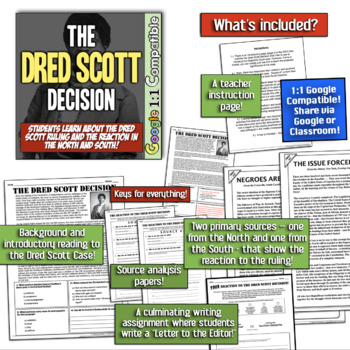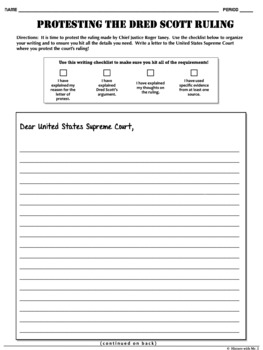Dred Scott Decision Student Reading | Primary Source Analysis
- Zip
- Google Apps™

What educators are saying
Description
Dred Scott Decision Student Reading | Primary Source Analysis
This resource on the Dred Scott Decision is also included in the much larger Sectionalism and Irreconcilable Period Bundle, located here:
Buy the Bundle and Save a Bundle!
----------
In this highly-engaging and Common Core focused lesson, students learn about the crucial Supreme Court case known as the Dred Scott decision, the reaction throughout the North and South, and how it further set the nation down the path of Civil War.
First, students complete an introductory reading activity on the Dred Scott decision which can serve as an all-inclusive resource if time is limited. Then, students analyze two newspaper primary sources that show the public reaction to the Supreme Court's ruling. One from the North and one from the South, students analyze these two sources to see how the ruling was felt throughout the nation and how it further divided the United States and led to Civil War.
To conclude, students write a "Letter to the Editor" as a culminating writing assignment where they either agree or disagree to a certain newspaper!
Very eye-opening lesson that creates multiple chances for meaningful conversations with your students!
This resource includes a paper in-class version and a 1:1 Google compatible version to be used in conjunction with Google Classroom. Just follow the included instructions for how to access the Google version, then share the resource through Google or assign via Google Classroom. This will allow students to type directly into the document!
----
Be sure to follow the History with Mr E Facebook page, and don't forget to signup for the Social Studies Newsletter to receive information on flash sales, product releases, and classroom tips!
----
Be sure to check out my other resources concerning sectionalism and the march toward Civil War:
The Sumner Caning: One Step Closer to Civil War! Engaging & Interactive!
The Webster-Hayne Senate Debate! Students analyze the Beginnings of Civil War!
Kansas and Nebraska Act & the beginnings of Lincoln Douglas Debates! Engaging!
Lecompton Constitution: Students analyze the debate over Kansas! Civil War!
John Brown: Hero or Criminal? Investigate John Brown's Legacy! Civil War!
Dred Scott Decision! The Argument, Ruling, Reaction, & Civil War! Common Core!
Sectionalism and The Irreconcilable Period Quiz! Buildup to Civil War! 1850s!
Nat Turner's Rebellion! A Student Webquest: Should Turner Be Remembered?





